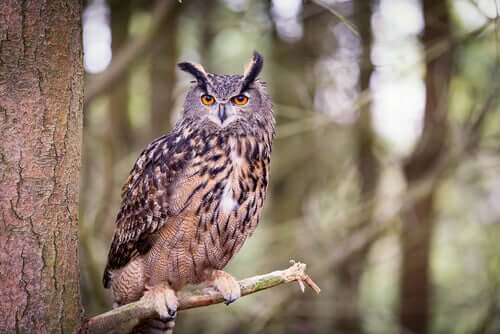The Master Techniques of Animals that Camouflage Themselves

We human beings use clothes to adapt to different situations. But other living creatures have a trick up their sleeve: camouflage. In this article, we’ll tell you more about some animals that camouflage themselves and the master techniques they use. They’re truly amazing!
Animals that camouflage themselves: how do they do it?
Camouflage, also known as crypsis, is the ability of some creatures to avoid being detected by other animals. This ability can be divided into four types:
1. Immobility
This is the easiest way to hide from predators, and it even includes slowing the animal’s breathing rate. This can help them to avoid being hunted by a reptile or amphibian that cannot see prey if it doesn’t move. At a more “advanced” level, some creatures even try to simulate the movements of other objects, such as a tree branch moving in the wind.
2. Coloration
This is the most common technique that creatures use to hide, and it involves assuming the color of the surrounding environment. In some cases, creatures can change their color depending on time and place (such as chameleons or cuttlefish). Other animals camouflage themselves depending on the time of year. For example, the Arctic hare has a white coat in winter and a brown coat in summer.
3. Patterns
An animal’s fur usually reflects their environment so as to make it difficult for predators or prey to see them. The most obvious examples of this are tigers and zebras. However, unlike other animals that change color, they cannot change their pattern in different environments.
4. Other types of crypsis
There is also something called non-visual crypsis, which interferes with auditory or olfactory perception. Examples include nocturnal butterflies, which emit sounds to confuse bats, or the squid that squirts ink to fool fish.
Masters of disguise
The chameleon is, without a doubt, one of the greatest camouflaging animals on the face of the earth. They have the ability to assume the color of a branch or leaf within seconds. This helps it to hunt its prey without being seen. Of course, it’s just one of many animals that camouflage themselves. Below is a list of other experts.

1. Owl
The owl is a nocturnal bird of prey whose feathers are adapted to their surroundings, in particular, trees. This means that they can sit on branches without being easily seen.
2. Flat-tail gecko
This is a reptile that lives among the trees or among the leaves that fall on the ground, and its brown body makes it look just like a leaf. When spawning among the rocks, there are no signs to suggest that there’s an animal hidden there.
3. Stonefish
Some sea creatures camouflage themselves too. As well as being one of the most poisonous fish in the world, the stonefish is also a master of hiding in its environment. It can stay in the same position for hours between the rocks on the seabed. This is the easiest way to catch food.
4. Stick insect
No one can deny that this insect is a professional when it comes to camouflage. Its long, brown body means that it looks just like the twigs and small branches in plants and bushes. During the day, they stay out of sight of predators, and, at night, they mate and feed.
5. Oakleaf butterfly
When you think of butterflies, you probably imagine a really colorful insect. However, in this case, its wings resemble brown leaves. This is its way of avoiding the beak or claws of predatory birds.
6. Cuttlefish
Another sea creature, this is a cephalopod that assumes the color of the place it’s perched on (just like a chameleon), whether its sand, rocks, coral, etc. How do they do it? They have a system in their cells that allows them to camouflage against any environment.
This text is provided for informational purposes only and does not replace consultation with a professional. If in doubt, consult your specialist.